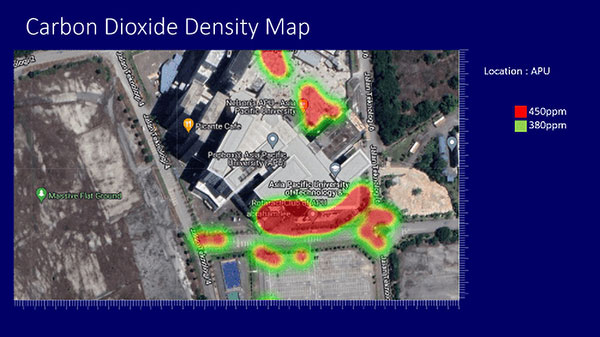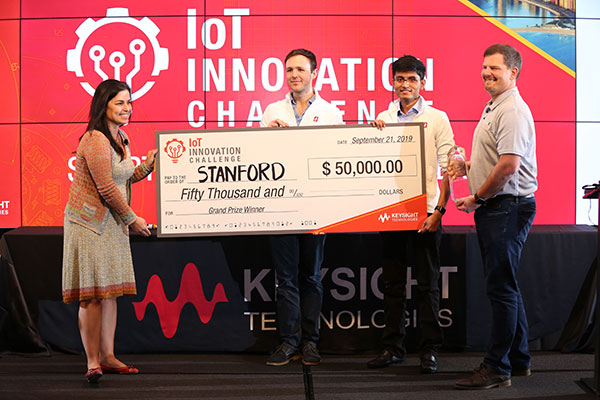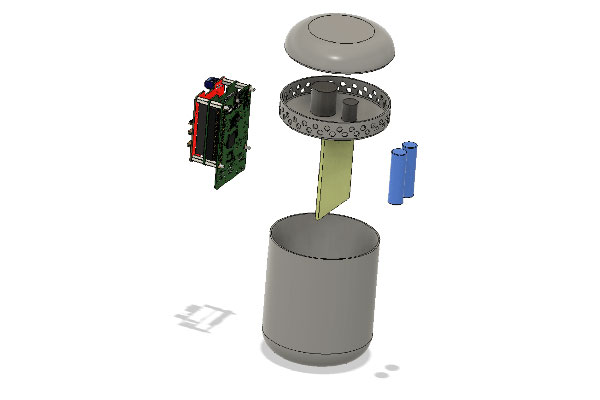Net Zero by 2050? Students Tackle the Challenge
Student Competition Profile: The Keysight Innovation Challenge

Keysight’s mission in the competition was to encourage students to innovate toward a UN goal, focusing on carbon neutrality monitoring. Image courtesy of Keysight Technologies and Jim Romeo.
Latest News
December 30, 2022
The Keysight Innovation Challenge began in 2019 as an exciting initiative to inspire the next generation of undergraduate and graduate engineering students. Students were invited from around the world to create an Internet of Things (IoT) sensor network to address the United Nations’ Sustainable Development goals around land and water. More than 8,000 people registered for the contest and 300 teams from around the world submitted entries.
Renee Morad is the innovation challenge lead for Keysight Technologies. We spoke to Renee to learn more about the competition and what some of the participants created.
Digital Engineering: Can you provide an overview of the Keysight Innovation Challenge competition, how it came to be, and the intent of the program? Who will participate or has participated?
Renee Morad: We provided an all-expenses-paid trip for two members of each of the six finalist teams to compete in the final competition in New York City in September 2019. The students competed on a global stage and shared their amazing innovations in front of a panel of judges.
We awarded a team from Stanford University $50,000 in cash prizes and $50,000 worth of Keysight equipment for their school and for their work on cloud-based water quality monitoring. Teams from Massey University in New Zealand, Universiti Tunku Abdul Rahman in Malaysia, and the Massachusetts Institute of Technology in the U.S. each received awards of $25,000 and $25,000 worth of Keysight equipment for their schools.
 Marie Hattar, Keysight’s senior vice president and chief marketing officer, and Joel Conover, Keysight’s senior portfolio marketing manager, award a prize in the 2019 Keysight Innovation Challenge to a team of students from Stanford. Images courtesy of Jim Romeo.
Marie Hattar, Keysight’s senior vice president and chief marketing officer, and Joel Conover, Keysight’s senior portfolio marketing manager, award a prize in the 2019 Keysight Innovation Challenge to a team of students from Stanford. Images courtesy of Jim Romeo.For the 2022 Innovation Challenge, Keysight also set on a mission to encourage students to innovate towards a United Nations goal. This year, our focus was on carbon neutrality monitoring. We asked teams of students around the world to create an IoT device or device network that will help the world reach net zero emissions by 2050.
The contest supports Keysight’s goal to achieve carbon neutrality within its Corporate Social Responsibility policies. We also took our efforts a step further to encourage greater gender diversity in science, technology, engineering and mathematics (STEM). We asked that each team have a woman leader and that there is at least equal representation of female to male students on each team. We received 52 entries from around the world and recently announced our top six finalist teams who [were to] go on to compete in the final competition on October 29, 2022. The top three teams will win up to $30,000 and up to $30,000 in Keysight equipment for their schools.
DE: Can you tell us about some of the designs that are part of the event and how they came to be?
Morad: The Keysight Innovation Challenge 2022 finalists are:
- Agata Wojcicka, Piotr Wawrzkiewicz, Martyna Iwanczyk, Mateusz Dabrowski, Michal Trzcinski and Weronika Lusa from Warsaw University of Technology in Poland for their entry, cloud-integrated pollution Analyzer
- Meredith Hunter, Kaitlyn Phan, Berke Lunstad and Grey Aycock from Vanderbilt University for their entry, EcoBuddy: IoT OBD2 monitoring device for fuel efficiency and emission consciousness
- Vaishali Maheshkar, Yaoli Zhao and Patatri Chakraborty from University at Buffalo, The State University of New York, for their entry, piezo-cantilever sensor for real-time monitoring of eight greenhouse gasses with LoRa communication
- Chloe Rubinowicz, Saurabh Saluja, Colin Prochnow, Kaya Jones, Anthony Banuelos, and Katarzyna Staron from the Illinois Institute of Technology for their entry, tree of life: carbon capture
- Kong Jee Ann, Jamie Young, Bryce Cheah and Wong Hui Yee from Asia Pacific University in Malaysia for their entry, autonomous carbon monitoring drone
- Muskan P, Ashwini Sai, Giri Dharan, Althaf Shaik, Belgin Jarosh and Nafisa Badruzaman from KCG College of Technology in India for their entry, carbon neutrality

Keysight’s top six finalist teams’ entries represent a versatile group of concepts, ranging from an autonomous carbon monitoring drone to a soil sensor “tree.” We’re thrilled to see gender diversity on each team, which is promising for our next generation of leaders in STEM. The Innovation Challenge is a meaningful way Keysight is actively working to inspire the next generation of student innovators, while encouraging a diverse pipeline of future engineering talent.
DE: Can you provide some examples of what the event has produced or what you expect it to produce?
Morad: One of the most valuable parts of the competition is witnessing firsthand the wonderful experience that the students gained from their participation. Gabriella Garcia, a student from MIT and 2019 Innovation Challenge winner, for example, recently recounted all that she gained from her experience. Our grand prize-winning team from Stanford recently shared that thanks to the Innovation Challenge, their work was published in a scientific journal. In the future, we hope to impact more students in this way.
DE: Does Keysight Technologies have a particular stance on adopting an innovation that is linked to the program? What drove Keysight to sponsor the event and coordinate it?
Morad: At Keysight, we set out not only to offer test and measurement solutions, but to inspire people to want to use those solutions in new and innovative ways—to make a difference in the world and to have a positive impact. We are so proud that the Innovation Challenge inspired so many students to find solutions to problems and in the process, helped chart the course of their engineering careers after school.
Depending on their grade level, Keysight is excited to provide all members of the top six finalist teams, informational interviews with Keysight this year for potential internships or job opportunities.

DE: Anything else you’d like to tell us about the event that the above questions haven’t given you the opportunity to express?
Morad: We encourage everyone to register on our Innovation Challenge website to stay up to date on our final competition, which will be livestreamed and announced soon.
Editor’s Note: To find out the winners, which were announced near presstime, visit this site.
More Keysight Technologies Coverage
Subscribe to our FREE magazine, FREE email newsletters or both!
Latest News
About the Author
Jim Romeo is a freelance writer based in Chesapeake, VA. Send e-mail about this article to DE-Editors@digitaleng.news.
Follow DE





